People react to the news of their country's latest nuclear test, at the Mirae Scientists Street in Pyongyang, North Korea, Sunday, Sept. 3, 2017. North Korea said it set off a hydrogen bomb Sunday in its sixth nuclear test, which judging by the earthquake it set off appeared to be its most powerful explosion yet.(AP Photo/Kim Kwang Hyon)
TOKYO (AP) — North Korea announced it detonated a thermonuclear device Sunday in its sixth and most powerful nuclear test to date, a big step toward its goal of developing nuclear weapons capable of striking anywhere in the U.S. The North called it a “perfect success” while its neighbors condemned the blast immediately.
Though the precise strength of the explosion has yet to be determined, South Korea's weather agency said the artificial earthquake it caused was five to six times stronger than tremors generated by its previous tests. It reportedly shook buildings in China and in Russia.
The test was carried out at 12:29 p.m. local time at the Punggye-ri site where North Korea has also conducted past nuclear tests. Officials in Seoul put the magnitude at 5.7, while the U.S. Geological Survey said it was a magnitude 6.3. The strongest artificial quake from previous tests was a magnitude 5.3.
North Korea's state-run television broadcast a special bulletin Sunday afternoon to announce the test. It said leader Kim Jong Un attended a meeting of the ruling party's presidium and signed the go-ahead order. Earlier in the day, the party's newspaper ran a front-page story showing photos of Kim examining what it said was a nuclear warhead being fitted onto the nose of an intercontinental ballistic missile.
The White House said President Donald Trump and his national security team planned a meeting later Sunday to discuss North Korea.
Trump said on Twitter that the North's “words and actions continue to be very hostile and dangerous” to the U.S. He called it “a rogue nation which has become a great threat and embarrassment to China, which is trying to help but with little success.”
China is by far the North's biggest trading partner, but Trump on Sunday appeared to be more critical of South Korean President Moon Jae-in, who has attempted to reach out to the North.
“South Korea is finding, as I have told them, that their talk of appeasement with North Korea will not work, they only understand one thing!” Trump tweeted.
Sunday's detonation builds on recent North Korean advances that include test launches in July of two ICBMs that are believed to be capable of reaching the mainland United States. Pyongyang says its missile development is part of a defensive effort to build a viable nuclear deterrent that can target U.S. cities.
China's foreign ministry said in a statement that the Chinese government has “expressed firm opposition and strong condemnation” and urged North Korea to “stop taking erroneous actions that deteriorate the situation.”
South Korea held a National Security Council meeting chaired by Moon. Officials in Seoul also said U.S. National Security Adviser H.R. McMaster spoke with his South Korean counterpart for 20 minutes about an hour after the detonation.
Japan's Prime Minister Shinzo Abe called the test “absolutely unacceptable.”
The nuclear test is the first since Trump assumed office in January. Trump has been talking tough with the North, suggesting it would see fire, fury and power unlike any the world had ever witnessed if it continued even verbal threats.
Nuclear tests are crucial to perfect sophisticated technologies and to demonstrate to the world that claims of nuclear prowess are not merely a bluff.
The North claimed the device it tested was a thermonuclear weapon — commonly called an H-bomb. That could be hard to independently confirm. It said the underground test site did not leak radioactive materials, which would make such a determination even harder.
At the same time, the simple power of the blast was convincing. Japan's Defense Minister Itsunori Onodera said it might have been as powerful as 70 kilotons. North Korea's previous largest was thought to be anywhere from 10 to 30 kilotons.
“We cannot deny it was an H-bomb test,” Onodera said.
North Korea conducted two nuclear tests last year and has been launching missiles at a record pace this year. It fired a potentially nuclear-capable midrange missile over northern Japan last week in response to ongoing U.S.-South Korea military exercises.
It said that launch was the “curtain-raiser” for more activity to come.
Just before Sunday's test, according to state media, Kim and the other senior leaders at the party presidium meeting discussed “detailed ways and measures for containing the U.S. and other hostile forces' vicious moves for sanctions.”
The photos released earlier Sunday showed Kim talking with his lieutenants as he observed a silver, peanut-shaped device that the state-run media said was designed to be mounted on the North's “Hwasong-14” ICBM.
The North claims the device was made domestically and has explosive power that can range from tens to hundreds of kilotons. For context, the bomb dropped on Hiroshima by the United States had a 15-kiloton yield.
North Korea's recent activity has been especially bold.
Pyongyang followed its two ICBM tests by announcing a plan to launch a salvo of intermediate range missiles toward the U.S. Pacific island territory of Guam. Kim signed off on the plan, but is watching the moves by the U.S. before deciding when or whether to carry it out.
Guam is a sore point for Pyongyang because it is home to a squadron of B-1B bombers that the North fears could be used to attack their country. The U.S. on Thursday had sent the bombers and F-35 stealth fighters to the skies of South Korea in a show of force — and North Korea strongly protested.
Options to pressure Pyongyang would appear to be limited. Further economic and trade sanctions, increased diplomatic pressure and boosting military maneuvers or shows of force would likely all be on the table.
The two Koreas have shared the world's most heavily fortified border since their war in the early 1950s ended with an armistice, not a peace treaty. About 28,500 American troops are deployed in South Korea as deterrence against North Korea.
AP writers Foster Klug, Youkyung Lee and Kim Tong-hyung in Seoul, Gillian Wong in Beijing and Mari Yamaguchi in Tokyo contributed to this report.
Visitors watch the north side through the glass showing a map of the border area between North and South Koreas at the Imjingak Pavilion in Paju, South Korea, Sunday, Sept. 3, 2017. North Korea says it has detonated a thermonuclear weapon at an underground testing facility in its sixth and most powerful nuclear test to date. The North is calling the test a 'perfect success.' The explosion registered on seismographs around the region as a strong earthquake and was met by immediate condemnation from Pyongyang's neighbors.(AP Photo/Lee Jin-man)
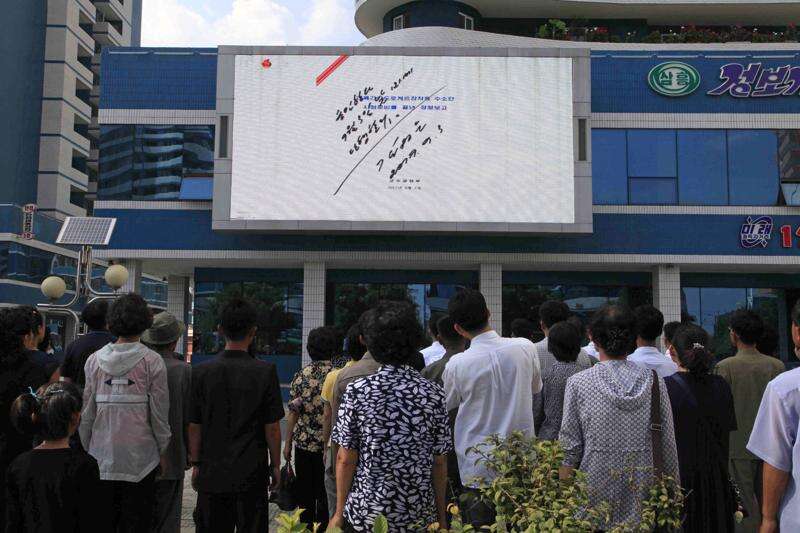
People gather and look at the news of their country's latest nuclear test seen on the screen, in Pyongyang, North Korea, Sunday, Sept. 3, 2017. North Korea said it set off a hydrogen bomb Sunday in its sixth nuclear test, which judging by the earthquake it set off appeared to be its most powerful explosion yet. The close of document with Kim Jong Un's signature on the screen read: "Approved. Conduct at 12 p.m. on Sept. 3. Kim Jong Un. Sept. 3, 2017."(AP Photo/Kim Kwang Hyon)
South Korean army soldiers patrol along the barbed-wire fence in Paju, South Korea, Sunday, Sept. 3, 2017. North Korea says it has detonated a thermonuclear weapon at an underground testing facility in its sixth and most powerful nuclear test to date. The North is calling the test a 'perfect success.' The explosion registered on seismographs around the region as a strong earthquake and was met by immediate condemnation from Pyongyang's neighbors.(AP Photo/Lee Jin-man)
South Korean President Moon Jae-in, left, arrives to presides over a meeting of the National Security Council at the presidential Blue House in Seoul, South Korea, Sunday, Sept. 3, 2017. North Korea said it set off a hydrogen bomb Sunday in its sixth nuclear test, which judging by the earthquake it set off appeared to be its most powerful explosion yet. (Yonhap via AP)

In this undated image distributed on Sunday, Sept. 3, 2017, by the North Korean government, shows North Korean leader Kim Jong Un at an undisclosed location. North Korea's state media on Sunday, Sept 3, 2017, said leader Kim Jong Un inspected the loading of a hydrogen bomb into a new intercontinental ballistic missile, a claim to technological mastery that some outside experts will doubt but that will raise already high worries on the Korean Peninsula. Independent journalists were not given access to cover the event depicted in this image distributed by the North Korean government. The content of this image is as provided and cannot be independently verified. (Korean Central News Agency/Korea News Service via AP)
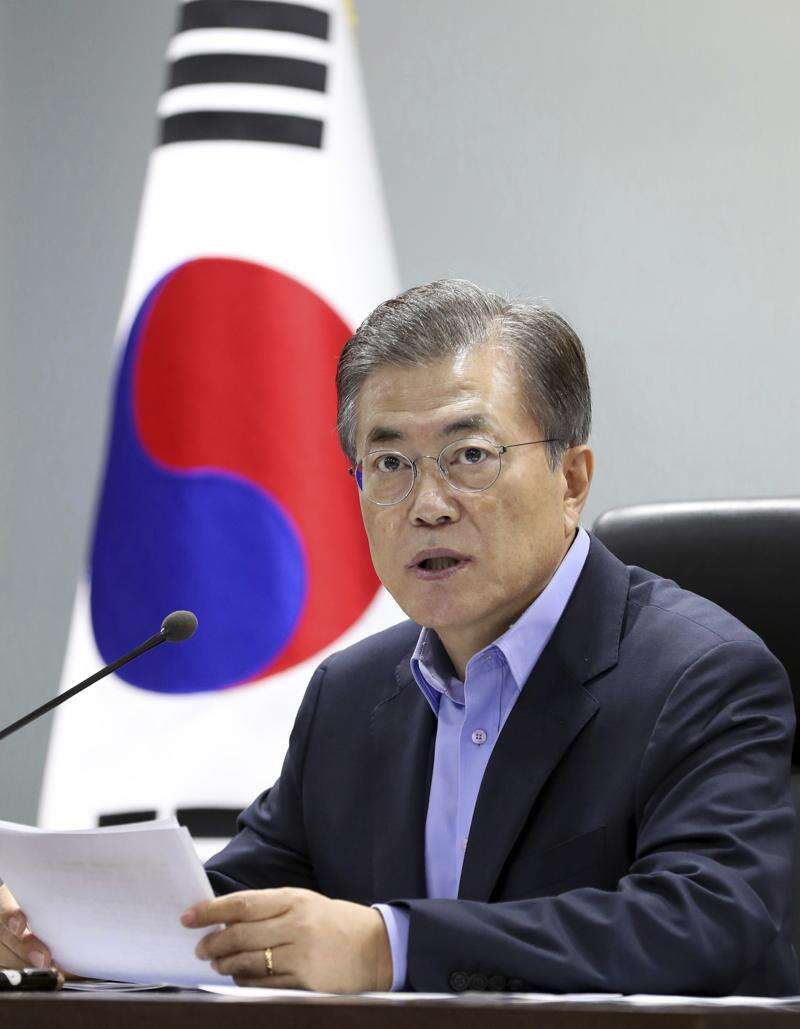
South Korean President Moon Jae-in speaks as he presides over a meeting of the National Security Council at the presidential Blue House in Seoul, South Korea, Sunday, Sept. 3, 2017. North Korea said it set off a hydrogen bomb Sunday in its sixth nuclear test, which judging by the earthquake it set off appeared to be its most powerful explosion yet. (Yonhap via AP)
People watch a TV news program showing North Korean leader Kim Jong Un at the Seoul Railway Station in Seoul, Sunday, Sept. 3, 2017. North Korea said it set off a hydrogen bomb Sunday in its sixth nuclear test, which judging by the earthquake it set off appeared to be its most powerful explosion yet. The signs read "North Korea, important announcement." (AP Photo/Ahn Young-joon)
People watch a TV news program showing North Korean leader Kim Jong Un at the Seoul Railway Station in Seoul, Sunday, Sept. 3, 2017. North Korea said it set off a hydrogen bomb Sunday in its sixth nuclear test, which judging by the earthquake it set off appeared to be its most powerful explosion yet. The signs read "North Korea, important announcement." (AP Photo/Ahn Young-joon)
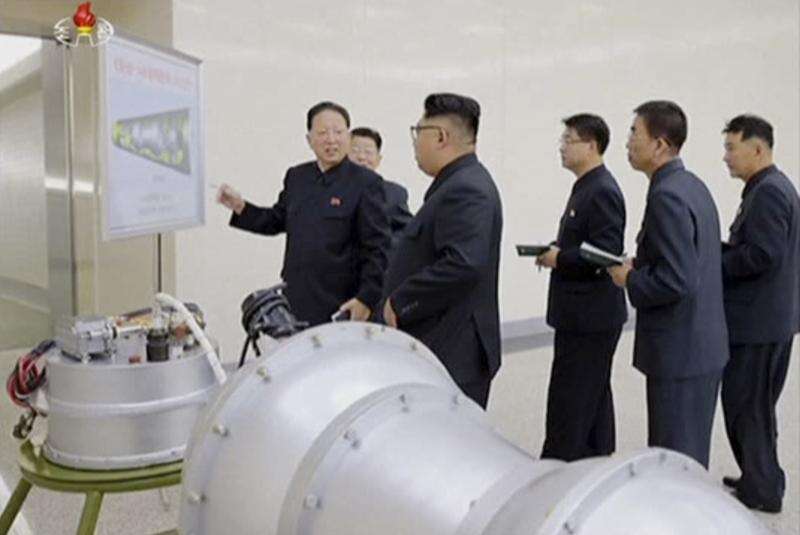
In this image made from video by North Korea's KRT released on Sunday, Sept. 3, 2017, shows North Korean leader Kim Jong Un at an undisclosed location. North Korea's state media on Sunday, Sept 3, 2017, said leader Kim Jong Un inspected the loading of a hydrogen bomb into a new intercontinental ballistic missile, a claim to technological mastery that some outside experts will doubt but that will raise already high worries on the Korean Peninsula. Independent journalists were not given access to cover the event depicted in this image distributed by the North Korean government. The content of this image is as provided and cannot be independently verified. (KRT via AP Video)
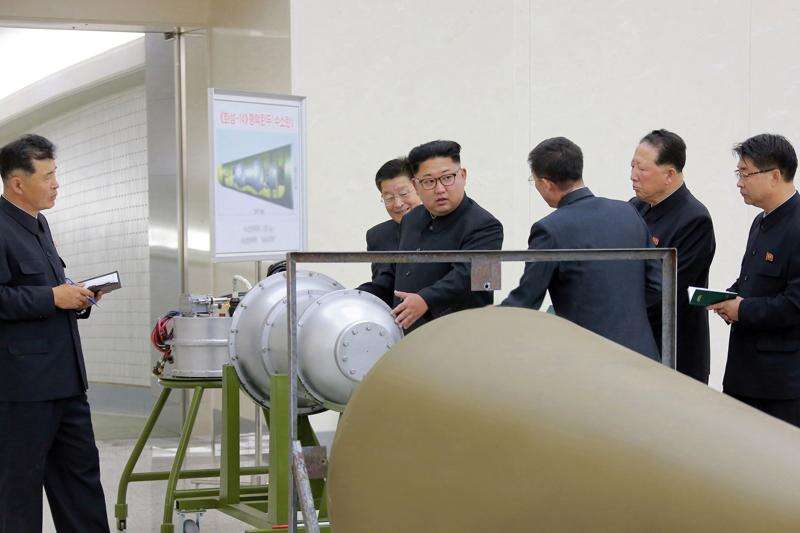
In this undated image distributed on Sunday, Sept. 3, 2017, by the North Korean government, shows North Korean leader Kim Jong Un at an undisclosed location. North Korea's state media on Sunday, Sept 3, 2017, said leader Kim Jong Un inspected the loading of a hydrogen bomb into a new intercontinental ballistic missile, a claim to technological mastery that some outside experts will doubt but that will raise already high worries on the Korean Peninsula. Independent journalists were not given access to cover the event depicted in this image distributed by the North Korean government. The content of this image is as provided and cannot be independently verified. (Korean Central News Agency/Korea News Service via AP)
People watch a TV news program at the Seoul Railway Station in Seoul, Sunday, Sept. 3, 2017, showing North Korea's announcement that it conducted an underground hydrogen bomb test. The signs read "Kim Jong Eun Listens to Nuclear Weapons." (AP Photo/Ahn Young-joon)
People watch a TV news program at the Seoul Railway Station in Seoul, Sunday, Sept. 3, 2017, showing North Korea's announcement that it conducted an underground hydrogen bomb test. The signs read "Kim Jong Eun Listens to Nuclear Weapons." (AP Photo/Ahn Young-joon)
Earthquake and Volcano of the Korea Monitoring Division Director Ryoo Yong-gyu speaks in front of a screen showing about artificial earthquake in North Korea, in Seoul, South Korea, Sunday, Sept. 3, 2017. North Korean TV says the country has successfully conducted a test of a hydrogen bomb that is meant to be loaded into an intercontinental ballistic missile. The letters read "Sixth artificial earthquake."(AP Photo/Lee Jin-man)
An officer from National Meteorological Center watches tv news programs showing pictures of North Korean leader Kim Jong Un in Seoul, South Korea, Sunday, Sept. 3, 2017. North Korea says Sunday, Sept. 3, 2017, that it has detonated a hydrogen bomb in a nuclear test that triggered a strong earthquake. The letters read "North Korea, important announcement." (AP Photo/Lee Jin-man)
Earthquake and Volcano of the Korea Monitoring Division Director Ryoo Yong-gyu speaks in front of a screen showing seismic waves that were measured on the South Korean peninsula, in Seoul, South Korea, Sunday, Sept. 3, 2017. North Korean TV says the country has successfully conducted a test of a hydrogen bomb that is meant to be loaded into an intercontinental ballistic missile. (AP Photo/Lee Jin-man)
People walk past a TV news reporting North Korea's a possible nuclear test in Tokyo Sunday, Sept. 3, 2017. South Korea's military said Sunday that North Korea is believed to have conducted its sixth nuclear test after it detected a strong earthquake, hours after Pyongyang claimed that its leader has inspected a hydrogen bomb meant for a new intercontinental ballistic missile. (AP Photo/Eugene Hoshiko)
A Chinese man walks by a display board showing photos of North Korean leader Kim Jong Un, high-rise buildings and ballistic missiles launches in North Korea, outside the North Korean Embassy in Beijing, Sunday, Sept. 3, 2017. North Korean TV said Sunday the country has successfully conducted a test of a hydrogen bomb that is meant to be loaded into an intercontinental ballistic missile.(AP Photo/Andy Wong)
A man drives his car past a display board showing photos of ballistic missile launches in North Korea outside the North Korean Embassy in Beijing, Sunday, Sept. 3, 2017. North Korean TV says the country has successfully conducted a test of a hydrogen bomb that is meant to be loaded into an intercontinental ballistic missile. (AP Photo/Andy Wong)
Earthquake and Volcano of the Korea Meteorological Administration Director Lee Mi-seon briefs to the media about artificial earthquake in North Korea, in Seoul, South Korea, Sunday, Sept. 3, 2017. North Korea likely conducted its sixth nuclear test Sunday, South Korea's military said after detecting a strong earthquake near the North's main nuclear test site. Hours earlier, Pyongyang claimed its leader had inspected a hydrogen bomb meant for a new intercontinental ballistic missile. The letters read "Sixth artificial earthquake." (AP Photo/Lee Jin-man)
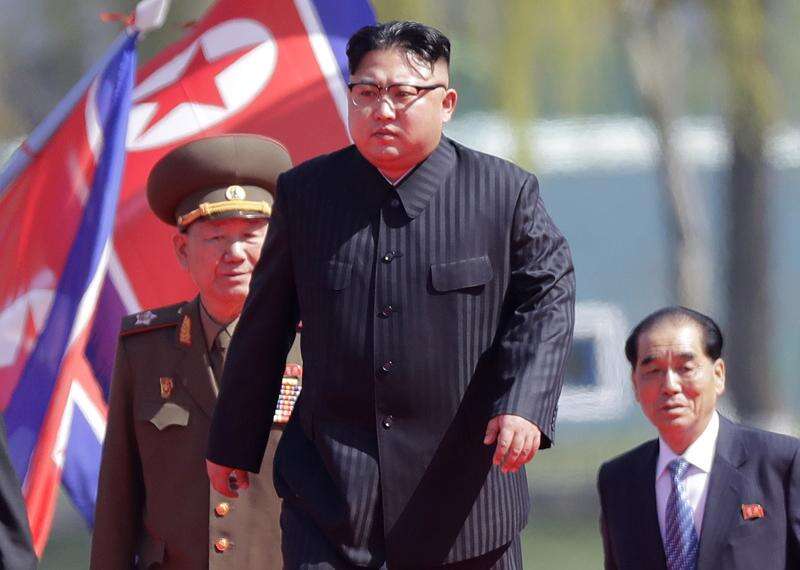
FILE - In this April 13, 2017 file photo, North Korean leader Kim Jong Un, center, arrives for the official opening of the Ryomyong residential area, in Pyongyang, North Korea. South Korea's military says North Korea is believed to have conducted its sixth nuclear test. South Korea's military said Sunday, Sept. 3, 2017, that North Korea is believed to have conducted its sixth nuclear test after it detected a strong earthquake, hours after Pyongyang claimed that its leader has inspected a hydrogen bomb meant for a new intercontinental ballistic missile. (AP Photo/Wong Maye-E, File)
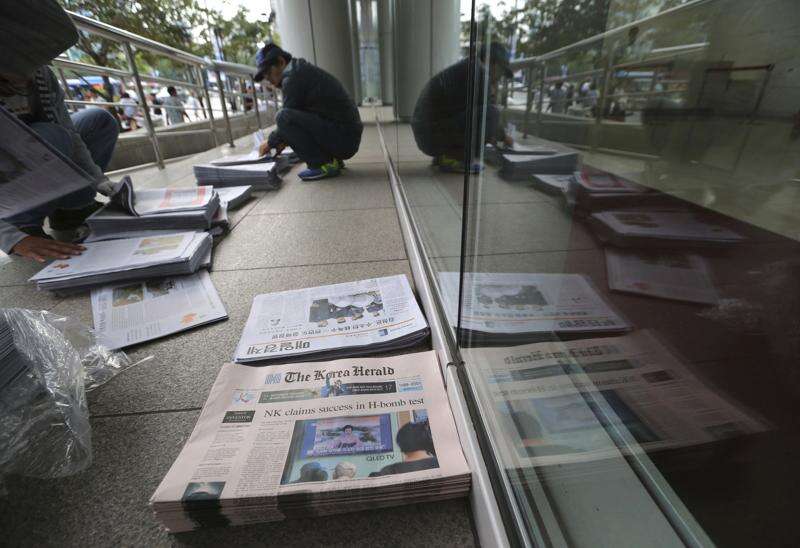
Workers arrange South Korean newspapers reporting about North Korea's hydrogen bomb test at a news paper distributing station in Seoul, South Korea, Sunday, Sept. 3, 2017. North Korea says it has detonated a thermonuclear weapon at an underground testing facility in its sixth and most powerful nuclear test to date. The North is calling the test a 'perfect success.' The explosion registered on seismographs around the region as a strong earthquake and was met by immediate condemnation from Pyongyang's neighbors.(AP Photo/Ahn Young-joon)